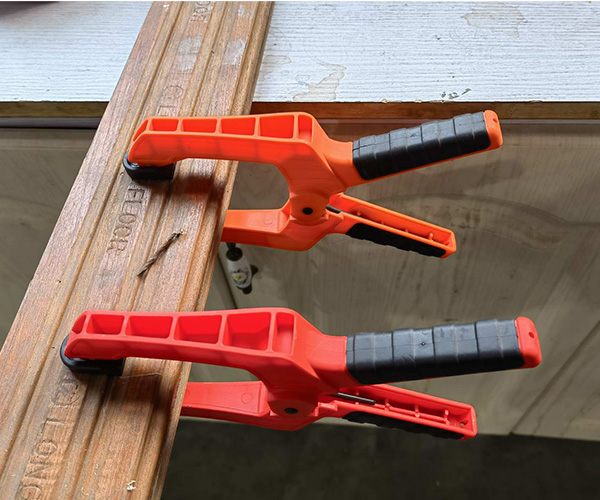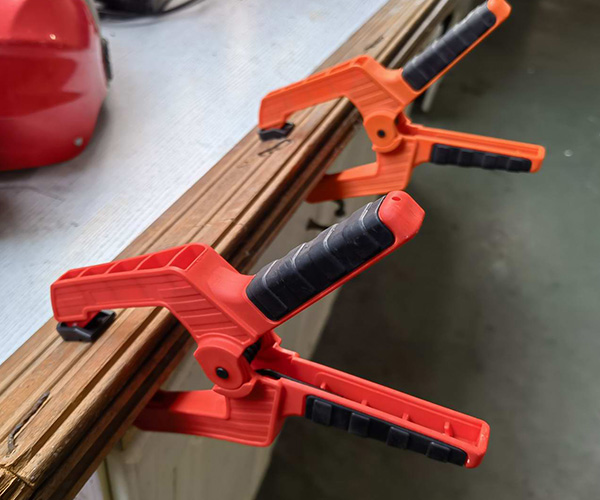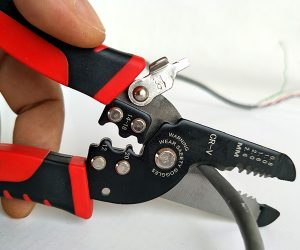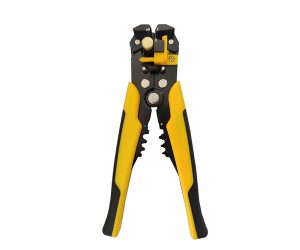Spring clamps are versatile tools used in a wide range of applications across various industries. Whether you’re a DIY enthusiast or a professional, understanding what a spring clamp is used for and how it can simplify tasks is essential. In this article, we’ll explore everything from basic definitions to its uses in different fields, helping you choose the right spring clamp for your needs and ensuring you get the most out of this essential tool.
1. What is a Spring Clamp and Why Should You Use It?
A spring clamp is a small yet powerful tool used for gripping materials tightly in place. It works by using a spring mechanism that allows it to apply constant pressure on objects, holding them securely. Unlike traditional clamps, spring clamps can be quickly applied and removed, making them an excellent choice for temporary holding.
What’s the real story? A spring clamp typically consists of two handles, a spring mechanism, and two gripping arms. These arms are lined with rubber or plastic pads to prevent damage to the surfaces being clamped. The tool’s strength comes from its spring, which makes it easy to apply and hold in place without requiring much effort.
But here’s the kicker: Spring clamps are incredibly versatile. They can be used in various fields, from woodworking and metalworking to arts and crafts. Their lightweight design and simple mechanism make them a favorite for quick fixes and precise tasks. Plus, they’re cost-effective, so you don’t have to break the bank to get the job done.
2. How Does a Spring Clamp Work?
A spring clamp works on a simple principle: tension. The spring inside the clamp creates pressure that forces the two jaws of the clamp to press tightly together. When you squeeze the handles, the spring compresses, and the jaws open to fit around the object you want to hold. Once you release the handles, the spring pushes the jaws back together, securely holding the object in place.
Ready for the good part? The mechanism is so simple that it requires little maintenance. However, using a spring clamp correctly is important to get the best results. To use one, position the clamp around the material you need to hold and squeeze the handles together. The jaws will apply pressure, holding the material securely.
Spring clamps come in various sizes, and selecting the correct size for your project is crucial. Too large, and you risk not getting enough tension; too small, and it won’t hold the material properly. The key is choosing the right balance based on the task at hand.
3. What Are the Key Benefits of Using a Spring Clamp?
Spring clamps offer several benefits that make them a popular choice for both professionals and DIYers. The primary advantage of spring clamps is their ability to apply consistent pressure, ensuring that materials stay in place during tasks like gluing, welding, or sanding.
What’s the real story here? Time-saving is one of the major benefits. Unlike other clamps, which can be time-consuming to set up, spring clamps are quick to apply. Simply squeeze the handles, and you’re done. This feature is especially helpful for fast-paced projects where efficiency is critical.
Additionally, spring clamps are incredibly versatile. From securing fabric during sewing projects to holding metal parts together in repairs, these clamps can tackle a variety of materials and tasks. Their portability and compact design make them easy to carry around, allowing you to complete jobs quickly without the need for bulky equipment.
4. What Are the Best Applications for Professionals?
Professionals across various industries use spring clamps for specific tasks where quick, reliable holding is needed. For instance, in woodworking, a spring clamp can hold two pieces of wood together while the glue sets. This quick application reduces downtime and helps ensure precise joints.
Here’s where it gets interesting: In metalworking, spring clamps are used to hold small pieces in place during welding or soldering. The clamp’s ability to apply consistent pressure makes it perfect for tasks where a secure hold is essential but does not require permanent fixation.
In car repair, spring clamps are often used to hold hoses or wires in place while mechanics work on other parts. They are quick to remove and do not require a lot of space, making them ideal for the confined areas often found under a vehicle’s hood.
5. What Are the Best Applications for DIYers?
Spring clamps are just as valuable for DIY enthusiasts as they are for professionals. In DIY woodworking projects, they can hold workpieces together while drilling or gluing. Their lightweight design makes them easy to maneuver, especially when working on small projects like picture frames or furniture repairs.
What’s the catch? Spring clamps are also incredibly useful for crafting projects. Whether it’s holding fabric together while sewing or attaching small decorative items to a base, these clamps make the process much more efficient. They can also be used to secure objects during painting, allowing DIYers to get creative without worrying about materials slipping out of place.
For home improvement tasks, such as fixing cabinetry or small repairs around the house, spring clamps are a quick and reliable solution. Their compact size makes them perfect for tight spaces, and their affordability makes them an excellent option for anyone looking to tackle small-scale projects around the home.
6. When Should You Choose a Spring Clamp Over Other Clamps?
While spring clamps have many benefits, they may not always be the best option. In cases where more heavy-duty clamping is needed, such as when securing large or heavy pieces of material, other clamps may be more appropriate. However, for light to medium tasks, a spring clamp is often the go-to solution.
What’s the real story? When compared to C-clamps or bar clamps, spring clamps offer more convenience, especially when you need to make quick adjustments. Unlike other clamps that require screws or bolts to tighten, spring clamps can be quickly applied and released with just one hand, saving valuable time in situations that demand speed.
However, there are limits to what spring clamps can handle. For larger-scale projects or those requiring a strong and long-lasting hold, you might need to consider stronger clamping solutions. Spring clamps excel in tasks where speed and convenience are more important than raw strength.
7. What Types of Spring Clamps Are Available?
Spring clamps come in a variety of sizes, materials, and designs. The most common materials are steel and plastic. Steel clamps are known for their strength and durability, while plastic clamps are lighter and more affordable. The choice of material depends on the specific task and the type of pressure needed.
Here’s where it gets interesting: In terms of size, spring clamps range from small, delicate models ideal for crafting projects to larger versions suited for woodworking or metalworking. Choosing the right size for your task is crucial—too small, and it won’t hold the material effectively; too large, and it could damage delicate surfaces.
For specialized tasks, you may also find spring clamps with additional features, such as cushioned pads or extended handles. These design enhancements can make the clamp more comfortable to use and improve its versatility.
8. Can Spring Clamps Be Used in Tight Spaces?
Spring clamps are an excellent choice for tasks that require working in tight spaces. Their compact design allows them to fit into areas that other clamps might not, making them a preferred tool for tasks such as car repairs or small craft projects. The ability to apply a firm grip without taking up much space is one of the reasons spring clamps are so popular.
What’s the catch? The size and shape of a spring clamp make it perfect for smaller jobs, but when working in extremely confined spaces, it can be difficult to apply enough pressure. In these situations, a clamp with a longer reach or a different mechanism might be necessary to achieve a stronger grip.
For most everyday DIY tasks, though, spring clamps are more than sufficient. Their ease of use and quick application make them the ideal tool for small-scale projects in tight, hard-to-reach areas.

9. How to Maintain and Care for Your Spring Clamp?
Proper maintenance of your spring clamp will ensure its longevity and effectiveness. Keeping the spring mechanism clean and free from rust is essential for smooth operation. To clean a spring clamp, simply wipe it down with a damp cloth and dry it thoroughly to prevent moisture buildup.
Ready for the good part? To prevent rust and extend the life of your clamp, it’s a good idea to occasionally lubricate the spring mechanism with oil. This reduces friction and keeps the clamp working smoothly. When storing your clamp, avoid leaving it in damp environments, as exposure to moisture can cause the metal parts to deteriorate.
Another tip is to regularly inspect your spring clamp for signs of wear, such as frayed springs or cracked handles. If you notice any issues, replace the clamp to avoid accidents during use. A well-maintained spring clamp will continue to provide reliable service for years to come.
10. What Are Some Common Mistakes to Avoid with Spring Clamps?
There are a few common mistakes that can lead to poor performance or even damage when using spring clamps. One of the most frequent mistakes is over-tightening the clamp. While it’s important to apply enough pressure to hold materials securely, over-tightening can lead to material damage or even break the spring mechanism.
What’s the real story here? Another mistake is using the wrong size clamp for the task at hand. If the clamp is too small, it won’t hold the material properly. Conversely, using a clamp that’s too large can result in uneven pressure, which can damage delicate surfaces. Always choose the right size for the job.
Finally, neglecting to check the condition of your spring clamp before use can lead to accidents. Always inspect your clamp for damage or wear before using it, ensuring it’s in proper working order.
11. How Do You Choose the Right Spring Clamp for Your Needs?
Choosing the right spring clamp involves considering the material, size, and application. For delicate materials, you’ll want a clamp with rubber pads to prevent damage. For heavy-duty tasks, a larger steel clamp with a stronger spring may be necessary.
Ready for the good part? The size of the clamp should also be chosen based on the size of the materials you’ll be working with. A larger clamp will be needed for bigger pieces, while smaller clamps are perfect for intricate, detailed work.
Budget is also a consideration. While high-quality spring clamps can be a bit more expensive, they tend to last longer and offer more reliable performance. When selecting a spring clamp, it’s important to balance quality, size, and cost to ensure you get the best value for your needs.
12. How Do Spring Clamps Compare to Other Clamping Tools?
Spring clamps are often compared to other clamping tools, such as C-clamps, bar clamps, and pipe clamps. The primary difference between spring clamps and other tools is the ease of use. While C-clamps and bar clamps require more time and effort to set up, spring clamps can be quickly applied with one hand, making them ideal for tasks that require speed and convenience.
What’s the real story here? However, when it comes to holding large or heavy materials, spring clamps may not provide the same level of strength as C-clamps or bar clamps. These types of clamps are better suited for heavy-duty tasks that require a more secure and long-lasting hold.
When choosing between spring clamps and other clamping tools, consider the nature of your project. For light to medium tasks, spring clamps are often the best option, while heavier projects may require more robust clamps.
13. Can Spring Clamps Be Used for Heavy-Duty Projects?
While spring clamps are excellent for light to medium-duty tasks, they may not be suitable for heavy-duty projects. Spring clamps have a limited clamping force, and for larger projects or materials that require a stronger grip, you might need to look into other types of clamps.
What’s the catch? For example, C-clamps and bar clamps offer a much more secure and stable grip for heavy-duty projects. These clamps are designed to handle significant amounts of pressure without compromising the material.
That being said, spring clamps can still be useful in heavy-duty projects when used for temporary holding or for tasks that don’t require an extended hold. They’re great for holding materials in place while preparing for more intense work with other clamping tools.
14. How to Avoid Injuries When Using a Spring Clamp?
Spring clamps, like any tool, come with safety risks if not used properly. The most common injury caused by spring clamps is pinching. When the clamp is released, the jaws snap together quickly, which can cause painful pinches if your fingers are in the way.
What’s the real story here? To avoid pinching injuries, always ensure that your fingers are clear of the jaws before releasing the clamp. Wearing protective gloves can also reduce the risk of injury. Additionally, always check the clamp for any broken parts or rust before use to ensure it works safely.
When teaching others how to use spring clamps, it’s important to emphasize safety. Make sure beginners understand how to handle the clamp properly, ensuring they avoid any accidents while working.
15. What Are Some Popular Brands of Spring Clamps?
Several brands are known for their high-quality spring clamps. Some of the most popular names in the industry include Irwin, Stanley, and Bessey. These brands offer a variety of spring clamps in different sizes and materials to suit various tasks.
What’s the catch? When choosing a brand, it’s important to consider the quality of the materials, the strength of the spring, and the comfort of the handles. Well-made spring clamps can last for years, so investing in a reputable brand is often worth the extra cost.

Each brand has its unique features, so it’s important to read reviews and choose the clamp that best fits your needs. For professionals, investing in high-quality spring clamps ensures reliability and long-term use.
FAQ Section
Q1: What is a spring clamp?
A spring clamp is a tool that uses a spring-loaded mechanism to apply pressure and hold objects in place temporarily.
Q2: How does a spring clamp work?
Spring clamps work by squeezing the handles together, which compresses the spring and allows the jaws to open and grip the material.
Q3: What are the best applications for spring clamps?
Spring clamps are ideal for woodworking, metalworking, DIY crafts, and car repair tasks, offering quick and reliable holding.
Q4: How do you maintain a spring clamp?
To maintain a spring clamp, keep it clean and lubricate the spring mechanism regularly to prevent rust and wear.
Q5: Are spring clamps suitable for heavy-duty tasks?
Spring clamps are ideal for light to medium-duty tasks, but for heavy-duty projects, other types of clamps like C-clamps or bar clamps are more suitable.





